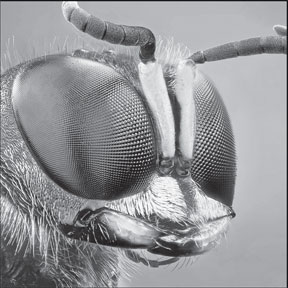A new way of seeing our world
 Today’s digital cameras are very advanced. Some of them will even
capture detail that the human eye cannot perceive. Some can work in
parts of the colour/light spectrum that we cannot fathom. On the other
hand, the human eye or for that matter, the eyes of most other animals
are very complex structures that have been engineered over millions of
years by Nature. Today’s digital cameras are very advanced. Some of them will even
capture detail that the human eye cannot perceive. Some can work in
parts of the colour/light spectrum that we cannot fathom. On the other
hand, the human eye or for that matter, the eyes of most other animals
are very complex structures that have been engineered over millions of
years by Nature.
While the human eye is no doubt a very complex structure, the eyes of
some other animals beat it hands down for sheer resolution. The cat in
your house can extract more details in near total darkness. An eagle can
clearly see the hair on the back of a rabbit being pursued. Many insects
have eyes that can detect even the tiniest movements.
Technology is catching up with these nature’s creations. According to
the latest report, the next generation of digital cameras could show us
how bugs see the world. This is no easy feat, given that insect eyes are
really complex organs.
Their dome-shaped eyes are packed with multiple tiny eye elements
topped with corneal lenses. The first digital camera prototype is
closest to the fire ant's compound eyes, which only have 180 of these
optical units, called ommatidia.
The praying mantis has about 15,000 and the dragonfly approximately
28,000, while the worker ant has only 100.
Researchers have now created a digital camera that imitates the
bulging eyes of insects, specifically fire ants and bark beetles. The
cameras can capture a 160-degree-wide field of view with nearly infinite
depth of field, meaning all areas of the photo will be in focus. The
tiny domes are covered in 180 microlenses, each capturing a unique angle
of the subject.
Engineering
“We feel that the insect world provides extremely impressive examples
of engineering - in the vision, flight, power and sensing systems. I,
personally, have been intrigued by the insect eye for as long as I can
remember,” says professor John Rogers of the University of Illinois, who
worked on the advanced camera.
 But why should someone build and want a bug-eye camera? This
technology could one day be used to create high-resolution But why should someone build and want a bug-eye camera? This
technology could one day be used to create high-resolution
surveillance cameras that capture a large, expansive scene, all in
sharp focus. They would also be an ideal fit Unmanned Aerial Vehicles
(UAVs) used for surveillance. It would also have practical applications
for high resolution endoscopic cameras, the small devices doctors use to
peek inside the human body. TV coverage of sports events could also
benefit.
As Rogers points out, Nature provides a remarkable diversity of ideas
for designs in cameras. “We think that it will be interesting to explore
some of these, because in many cases, the concepts offer unique and
powerful capabilities in imaging.”
Most digital cameras have a flat sensor and a single camera lens. The
working prototypes of this digital camera have hundreds of lenses
instead of one and bend the basic elements found in a digital camera
into a rounded shape.
The images are recorded in their original shape on a computer, though
they can be flattened if necessary for printing purposes. The resolution
of the experimental camera is on par with the fire ant.
Researchers think they can improve that with more advanced
manufacturing facilities.
The team is already preparing to manufacture the next versions of the
technology: digital cameras that imitate the even more complex compound
eyes of shrimp, lobsters, moths and houseflies.
This is not dissimilar to a new invention called the Lytro camera,
which works by employing a micro lens array to capture the entire light
field - every ray of light traveling in all directions through a scene,
which regular cameras cannot do - before focusing the information
captured onto a sensor.
Collecting all light data enables users to alter a picture's focus
and perspective long after the image has been taken. The camera,
invented by Malaysian scientists Ren Ng, is expected to hit the market
in a few years.
Better cameras that take cues from Nature could have another
practical application: enabling blind persons to ‘see’ at least a
rudimentary outline, if not a full-blown picture. The eye in any animal
covers only half of the picture, so to speak. To get the full picture,
the brain has to process the information sent by the eyes.
Condition
There is some hope for blind people whose optic nerve is in a
satisfactory condition, if it can be connected to an artificial (Bionic)
eye. There are several such devices in testing stage right now. The
first artificial retina was approved for clinical use a few weeks ago.
Another team of scientists said they had developed a retina implant that
can convert images into electronic signals that can be interpreted by
the brain. The device - the Argus II - is a camera mounted on a pair of
glasses, which sends information to a chip resting on the retina.
The chip is able to send signals through the optic nerve to the
brain, giving the user a low-resolution - but real - realtime image of
the world. This also gives rise to another possibility - robots whose
eyes are actually better than those of ours.
There is already talk of more intelligent, almost autonomous robots
coming up in the not too distant future. They will need vision that can
complement their ‘intelligent’ capability.
However, robots need not necessarily be humanoid in shape and size -
they can be made in almost any shape. There could be many practical
applications such as inspecting minute cracks in oil pipelines using
robots that can ‘see’ exceptionally well.
In the meantime, camera enthusiasts will have very exciting and
technologically advanced cameras in their hands soon. Even with the
sheer variety of cameras in the market now, there is still room for
innovative cameras that can capture a scene from a unique perspective.
However, there is a lag between research prototypes and the
commercial introduction of a given product, which can impede the
progress of technology. Universities and private companies must
collaborate more effectively on research projects to bring products to
the markets sooner, especially when it involves an option such as a new
way of seeing the world.
|


